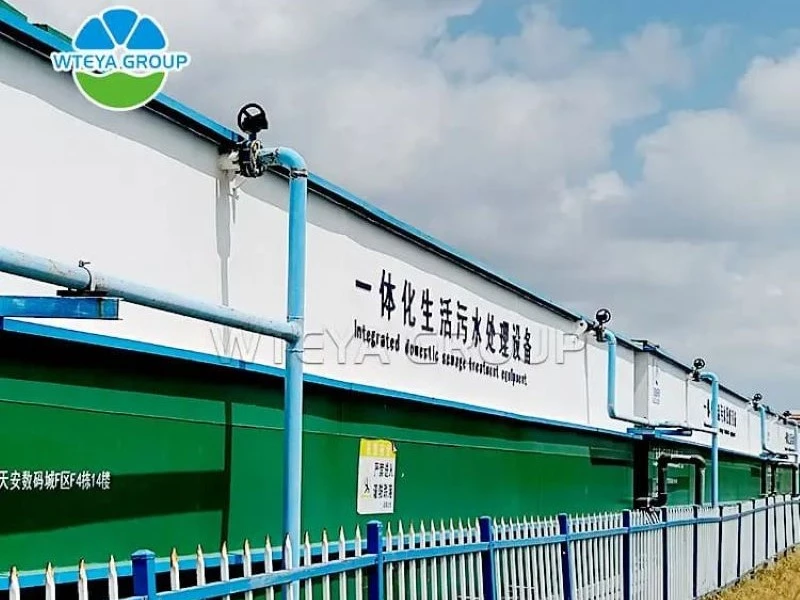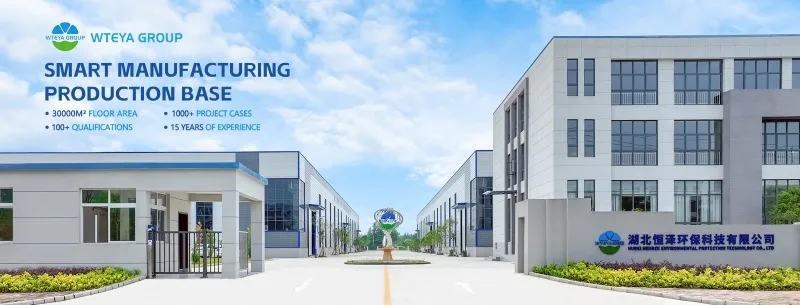Turning wastewater into clean water: Learn about the technology behind wastewater treatment plants
Wastewater treatment plants play a vital role in modern society, transforming polluted wastewater into clean, reusable water. With growing concerns about water shortages and pollution, the technology behind wastewater treatment has become increasingly sophisticated. WTEYA will provide a detailed look at how wastewater treatment plants work, the types of treatment facilities, their impact on the environment, and the future trends shaping the industry.

How Wastewater Treatment Plants Work
Wastewater treatment plants remove pollutants from wastewater through a multi-step process. The general treatment process consists of three main stages: primary treatment, secondary treatment, and tertiary treatment.
Primary Treatment
The first stage involves the physical removal of large solids from wastewater. This is achieved through screening and sedimentation. The water flows through large screens, which screen out debris such as plastics and large organic matter. The remaining water then enters a sedimentation tank, where heavier particles such as sand and sludge settle to the bottom.
Secondary Treatment
This stage focuses on removing dissolved organic matter and microorganisms. Biological treatment methods such as activated sludge or trickling filters are used. In activated sludge systems, bacteria break down organic pollutants, while in trickling filters, wastewater passes through a bed of rock or other material that supports the growth of microorganisms.
Tertiary Treatment
The final stage involves polishing the treated water to meet specific quality standards. This may include further filtration, disinfection with chlorine or ultraviolet light, and the removal of nutrients such as nitrogen and phosphorus. Tertiary treatment ensures that the water can be safely discharged into rivers and lakes, or reused in certain industrial applications.
Types of Wastewater Treatment Plants
Wastewater treatment plants are classified into several types depending on the source and nature of the wastewater they treat:
Municipal Wastewater Treatment Plants
These plants treat wastewater from residential, commercial, and public sectors. They are designed to treat large volumes of water and are often equipped with advanced treatment technologies to meet environmental discharge standards.
Industrial Wastewater Treatment Plants
Industrial plants are used to treat wastewater generated by factories, refineries, and other industrial activities. These plants treat more complex contaminants, including chemicals, heavy metals, and other toxic substances, and often require specialized treatment methods such as chemical precipitation or reverse osmosis.
Decentralized Wastewater Treatment Plants
Smaller decentralized plants are used in rural areas or smaller communities where large-scale infrastructure is not feasible. These systems are typically designed to treat smaller volumes of wastewater and are very efficient in terms of space and operation.
Future Trends in Wastewater Treatment Plants
Smart and Automated Systems
The future of wastewater treatment lies in smart technology. Smart systems are being integrated into treatment plants to monitor water quality, automate processes, and improve efficiency. Sensors, data analytics, and artificial intelligence are used to predict maintenance needs, detect anomalies, and ensure optimal operation without human intervention.
Modular and Compact Design
With increasing urbanization and limited space, there is an increasing demand for compact, modular wastewater treatment plants. Designed to be easy to install and flexible, these small units are ideal for urban areas and decentralized applications.
Resource Recovery and Water Reuse
As the demand for clean water increases, wastewater treatment plants are evolving to focus on resource recovery. This includes recovering biogas from sludge, extracting valuable minerals, and facilitating water reuse. Some plants are already purifying treated wastewater for use in agriculture, industry and even drinking water.
Impact of Wastewater Treatment Plants on the Environment
Wastewater treatment plants play a key role in protecting the environment. Proper treatment helps to:
Maintain water quality
By removing contaminants, treated wastewater can be safely returned to rivers, lakes, or oceans, preventing contamination of natural water bodies and protecting aquatic ecosystems.
Improved Air Quality
Modern treatment plants are designed with systems to control odors and reduce the release of harmful gases such as methane and sulfur compounds, ensuring that they do not negatively impact the surrounding air quality.
However, improperly managed plants can be harmful to the environment, especially if sludge is not handled properly or chemical treatments leak into the environment.
Advantages of WTEYA Wastewater Treatment Plants
Compact Design and Space Efficiency
Modern wastewater treatment plants are designed to be space-efficient, allowing them to fit into smaller spaces without compromising treatment capacity. This is particularly important in densely populated urban areas where land is limited.
Deployment Flexibility
These plants are modular in design and highly flexible. They can be easily expanded or relocated based on changing needs, making them ideal for rapidly growing urban centers or temporary applications.
Efficiency and Real-Time Monitoring
Today’s treatment plants offer real-time monitoring of system performance, water quality, and operating status. This data-driven approach helps identify inefficiencies, improve treatment results, and enable proactive maintenance, thereby improving overall operational efficiency.
Predictive Maintenance and Alerts
With integrated smart technologies, wastewater treatment plants can now predict potential problems before they occur. Automated alerts notify operators of any faults or abnormalities, enabling them to take corrective action before the situation worsens.
Water Use Insights
Monitoring systems provide operators with detailed insights into water use and treatment effectiveness, making it easier to optimize processes and ensure sustainable water management. This transparency helps conserve water and reduce energy consumption.
Conclusion
Wastewater treatment plants are essential to maintaining a clean and safe water supply while protecting the environment. As technology continues to advance, future wastewater facilities will be smarter, more compact, and more capable of reusing precious resources. By adopting these innovations, cities, and industries can play an active role in addressing water scarcity and creating sustainable water systems for the future.

Why choose the WTEYA Group Wastewater Treatment Plant?
WTEYA Group provides excellent wastewater treatment plants that meet the unique needs of various industries and communities.
More than ten years of rich experience: WTEYA has provided efficient and reliable water treatment solutions to many well-known companies around the world. Successfully implemented projects for listed companies such as Foxconn, Huawei, Ganfeng, Rongbai, etc., with more than 100 project cases, and won the trust and praise of customers.
Tailor-made solutions: Customized systems for various water treatments to meet the various needs of enterprises. Support OEM&ODM customization.
Supporting automatic online monitoring system: Real-time online monitoring of water treatment effects, while having abnormal alarm and predictive maintenance functions to ensure treatment results.
WTEYA Group's wastewater treatment plants combine decades of experience, tailor-made solutions, and cutting-edge monitoring technology to provide the best results for your water treatment needs. Our commitment to quality and customer satisfaction ensures that you get an efficient and sustainable system.
*Email: info@wteya.com
*WhatsApp: +86-18002840855
Contact us today to learn more about how WTEYA Group can provide the ideal wastewater treatment solution for your business or community. Let us help you create cleaner, safer water and a healthier future together.







